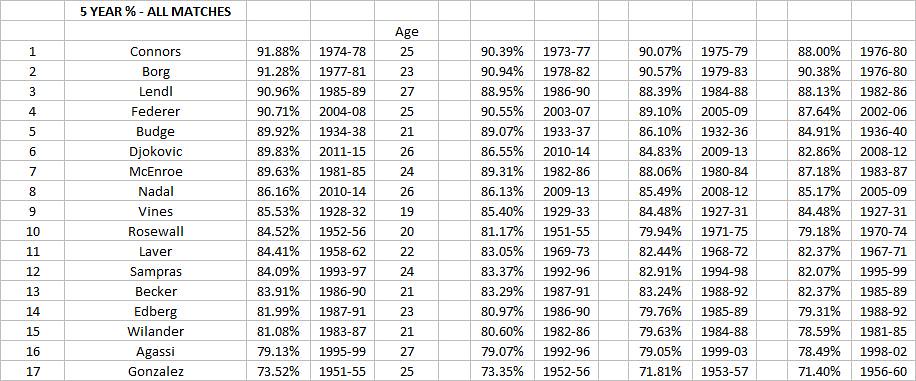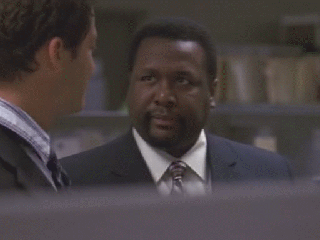That's the usual breakdown people give about these two, that Pete would win on the faster courts while the slower conditions would favor Fed, but while like most cliches this one has a grain of truth I do find the reasoning behind it incomplete if not outright flawed. First off I don't buy the common wisdom that AO equals slow hard while USO is faster, because the facts simply don't support it. And the latest AO/USO editions do tell a different story: players won 64.4% of their total points on serve (18,494 SPs won out of 28,723 total points, if you're interested) Down Under this year, as opposed to 63.7% (17,377/27,300) at last year's USO. In fact the 9.7% of aces per point played (2789/28,723) at this year's AO is actually higher than even Wimbledon's 9.6% (2785/28,975) and clearly higher than the 2015 USO's 9.0% (2450/27,300). (That said Wimby still reigns over them all in % of SPs won and RG remains most likely the slowest: 65.8% vs. 62.0%.)
And that's not not just in the past year. This trend has held firm for some time now (scroll down for aces per point):
http://www.tennisserver.com/lines/lines_13_01_27.shtml
That's why I say people are fooling themselves when they claim to know a certain HC is faster or slower than another, and why I think Novak's purported superiority to Pete and even Fed at the AO is less due to their respective surface-specific prowess than to the event's
timing. And remember, while Plexicushion may be slower than Rebound Ace (though I've yet to see much convincing evidence for it) it's reportedly more conducive to even bouncing and less prone to overheating, both of which Pete would prefer as he makes it clear in his book that it was the AO's unpredictable conditions rather than its slow courts that troubled him. Given these developments it's not at all reaching to say Pete in this era would've done actually better Down Under, not worse.
Also people tend to dismiss Pete's chances against Fed or any other non-ATG on clay too easily. Perhaps that's understandable given his woeful results on the surface after '96-97, but before then he was actually one of the top contenders at RG. As I've
noted before Pete's and Fed's stats during their prime on the surface are in fact eerily similar. I actually think these two would play each other close just about anywhere. Not to say that Pete would hang with Fed all the way on dirt, because small things do matter in any matchup, but it'd be closer between the two than most people think.
And one more thing....
That's a good way to put it. Again I do think your position is quite defensible, but let me add a few more stats to this discussion that might prove helpful. I've already
shown how Pete not only held serve but also broke serve more often than Fed in their respective Wimbledon finals which they won (so Fed's losses are excluded lest there be statistical skewing of any kind), and I believe others since have
called attention to the fact that Pete actually won a higher % of his service games in his 7 finals than in his previous rounds overall at SW19. And I don't think this upsurge on Pete's part in big matches is limited only to Wimbledon. I recall reading about Fed's exceptional TB record compared to other ATGs (including Pete, obviously), and while people were saying the obvious things I was also thinking, what if that's because of Fed's relatively inferior record on BPs which would presumably lead to more TBs (most of which he'd win against presumably his lesser opponents)?
So I ran the numbers and it turns out that Pete played 11 TBs in his 14 final wins, or 0.79 TB/match, while Fed has played 18 TBs in 17 major final wins, or 1.06 TB/match. Which means Pete indeed broke his opponents more often than Fed, and remember, we're talking finals won only, which means we're mostly excluding Fed's major finals against his nemesis Nadal so there should be little nitpicking about competition here. And Pete did play fewer sets than Fed per major final won, 3.5 (49 sets/14 matches) vs. 3.59 (61/17). Now obviously that's a negligible difference, but what's really striking about these numbers and also the Wimbledon stats is that Pete was at the very least able to match Fed on return in their major finals even though Roger is supposed to hold the advantage here. And I suspect Fed would also hold the expected statistical edge in the previous rounds of their non-Wimbledon GS runs, so the question is, might it be the case that Pete did indeed raise his game more than Fed or Borg for that matter in big matches?
You can probably guess what my answer would be and I don't have the time to elaborate further, but I thought these factoids could steer this thread in a different direction. Also I think you guys are selling Mac a tad short. Though Pete is my guy I'd feel quite uncomfortable if I had to bet on him or Fed getting the better of peak Mac in these imaginary matchups. I don't think most of us hackers (yes I'm including myself in that group) don't fully understand what Mac was truly capable of. I remember this gem of a post by good old Datacipher on Mac's game that I felt mirrored the perceptive awe of what I've heard from guys who really know their tennis, those with years of teaching and training under their belt who have groomed many a budding professional player. One can tell they can see things in Mac that we don't, and it's that ineffable genius which allowed him to put together a
level of dominance (however brief) that not even Fed or Novak could match, and which is why, push comes to shove, I'd probably include him in my all-time top 10 even though there are a few others with a more well-rounded resume.


